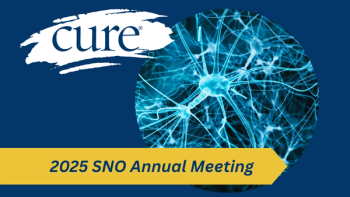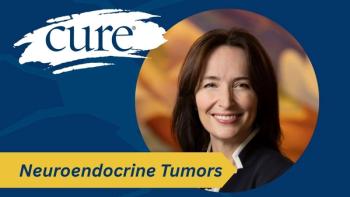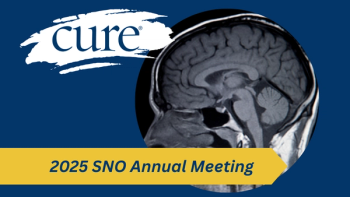
New Advances in Gastroesophageal Cancers
Dr. Daniel H. Ahn, D.O., spoke with CURE about new advances in gastroesophageal cancers including immunotherapies and stemness inhibitors.
The armamentarium of gastroesophageal cancers is starting to expand, explains expert Daniel H. Ahn, D.O., with a variety of agents being explored at a rapid pace.
For example, the double-blind, placebo-controlled phase 3 INTEGRATE 2 trial will investigate the potential of Stivarga (regorafenib) for patients with refractory advanced gastroesophageal cancer (NCT02773524). In the study, which is not yet recruiting, researchers will determine whether the oral multikinase inhibitor improves overall survival (OS).
Additionally, there is the stemness inhibitor napabucasin (BBI-608), which was granted an orphan drug designation by the Federal Drug Administration (FDA) in June 2016 as a treatment for patients with gastric or gastroesophageal junction cancer. The designation was based on early-phase data from the BRIGHTER trial. Here, the agent showed an objective response rate (ORR) of 15 percent and a median progression-free survival (PFS) of 13 weeks. In patients who did not receive a taxane in the metastatic setting, the ORR was 31 percent and the median PFS was 20.6 weeks. The ORR was 50 percent in patients who received just one prior therapy that was not a taxane.
Immunotherapies are also demonstrating early potential in gastroesophageal cancers, Ahn adds, specifically PD-1 antibodies alone and in combination with chemotherapy.
“The main thing is to recognize that there may be better treatment strategies, in terms of providing a neoadjuvant approach and immunotherapy is a viable and relevant treatment option,” Ahn says. “Where this ultimately falls — whether it’s second-, third- or fourth-line therapy — still needs to be determined. But, it should be included somewhere along the lines and, if a patient is not really tolerating chemotherapy, I would consider moving it up to even the second-line setting.”
Can you provide a summary of your presentation?
Ahn, an assistant professor at Mayo Clinic, shared these updates in the gastric cancer landscape during the 2017 OncLive® State of the Science Summit on Gastrointestinal (GI) Malignancies. In an interview during the meeting, he spoke on biomarker developments, agents emerging in the pipeline and exciting data out of the 2017 GI Cancers Symposium.Ahn: We discussed the recent updates in esophageal and gastric cancer. We mainly focused on gastroesophageal junction cancer in the lower esophagus as well as gastric cancer — so mainly the adenocarcinomas.
What biomarkers are now in development?
Essentially, there were discussions on biomarkers with potential targeted therapies in gastroesophageal cancer, followed by neoadjuvant approaches and, lastly, what the future direction is in treating these malignancies. Mainly, there are several relevant targets that are active treatment options in gastroesophageal cancer. The main one is VEGFR-2. While the AVAGAST study was negative with Avastin (bevacizumab) in the first-line setting, we see in the second-line setting that VEGFR-2 is a relevant target. We have seen that over and over again with multiple different agents, including apatinib and, most recently, Cyramza (ramucirumab).
What are the challenges with biomarker development in this field?
Based on this, there are ongoing trials. It is mainly the INTEGRATE 2 trial, which Mayo Clinic is going to be a part of. In this study, we’re looking at the role of Stivarga in the refractory setting as a targeted agent. What we’ve seen in earlier studies, in the phase 2 INTEGRATE 1 study, is that this is a relevant target improving not only PFS, but there might be also be an OS benefit for patients with refractory gastric cancer.There is still a lot of area of uncertainty and a lot of unknowns in this area. The main thing that seems to be a hot area — not just in gastric cancer, but in all GI malignancies — is PD-1/PD-L1. What we saw from a recent phase 3 study presented at the 2017 GI Cancers Symposium is that this is a relevant target.
What updates are occurring in the neoadjuvant setting?
What we are going to try to do is to stratify and identify which patients are going to benefit the most. Even some of those who were weak PD-1 expressers, based on early phase 1 data, still had some benefit. We are trying to extrapolate who may benefit and who may benefit even further.There have been a lot of interesting developments in the neoadjuvant setting, mainly with the combination of PD-1 inhibitors plus chemotherapy. Currently, the treatment strategy is chemotherapy, usually with carboplatin/paclitaxel, in combination with concurrent chemoradiation. This is based off of the CROSS trial.
However, there appears to be some interesting data that the combination of PD-1 inhibitors with chemotherapy may not only have a benefit locally, but there may potentially be an abscopal effect where it not only controls the local disease, but also prevents any disseminated or metastatic disease in the future.
We are currently running a phase 1b study led by Dr. Harry Yoon in Mayo Clinic in Rochester, Minn., and Mayo Clinic in Arizona will also be participating. Here, we are studying the combination of carboplatin/paclitaxel with Keytruda (pembrolizumab) in combination with radiation therapy.
The other area that seems to have a lot of interest in the neoadjuvant setting is PET-CT as a way to identify patients who are actually responders to chemotherapy and radiation.
The initial results of the CALGB 80803 (Alliance) trial were also presented at the 2017 GI Cancers Symposium. The results were very preliminary, but it showed that in patients who do not have a PET-CT response — which they identified as a less than 30 percent response in FDG avidity — was switched to a different type of chemotherapy. Patients were initially randomized to FOLFOX or carboplatin/paclitaxel and, based on the PET-CT response, they would either continue current therapy or switch to alternate therapy.
Can you hone in on the synergy behind those types of combinations?
What are the future directions of this field?
It showed that this would be a viable way to treat gastroesophageal cancer. However, the results were preliminary and, as the data matures, we’ll be able to identify whether or not this is a viable treatment strategy in this disease. That’s a good question. Some of the data suggest that when you treat with chemotherapy and radiation, we increase tumor-specific antigens or epitopes by combining with PD-1/PD-L1. This will allow the immune system to recognize these antigens as being formed. It could have not only a local control, but also have a systemic control, act as a guardian and stop the cancer from spreading.With immunotherapy, one area of interest is the combination of multiple different agents. There has already been some early data in the phase 1b setting with the combination of multiple different immunotherapy agents. The data look very promising and this is an area that will continue to be developed. While it’s a small sample, it looks like the response rates are greater than 30 percent in this patient population with the combination of different immunotherapy agents.
Another area that seems to be a very hot topic across all GI malignancies is the JAK/STAT pathway.
There is a lot of interest in an agent called BBI-608, which is currently under investigation in multiple phase 3 studies in other GI malignancies, which is looking at attacking the stem cells of cancer cells — which tend to be the most indolent and treatment resistant of all cancer cells.
Can you explain the mechanism of action of BBI-608?
What other data out of the 2017 GI Cancers Symposium were practice changing?
In terms of gastric cancer, the BRIGHTER study looked at the combination of paclitaxel with BBI-608 so, hopefully as data matures, that will give us some further insight as to whether or not this is a relevant treatment strategy in this disease.Mainly, it attacks the STAT pathway and inhibits the pathway from where the underlying root of these cancer stem cells that tends to be resistant to chemotherapy. It looks like there might be some synergistic effects when you combine it with chemotherapy. The early phase 1b data showed that, in patients who never received any prior taxol therapy, the response rate was up to 31 percent. It looks like a viable treatment strategy — not only attacking the stem cells, but also the other cancer cells.The main thing was in immunotherapy. When we saw the initial phase 1b data from the KEYNOTE-012 study [of Keytruda in advanced gastric cancer], that looked like it was really promising. While this phase 3 data was mainly in East Asia, it kind of validated all of the information that we knew about PD-1 being a relevant treatment strategy across all patients with gastric cancer.





